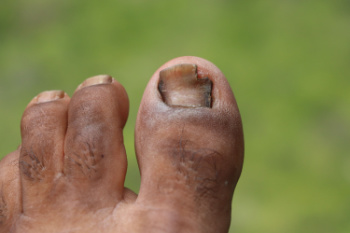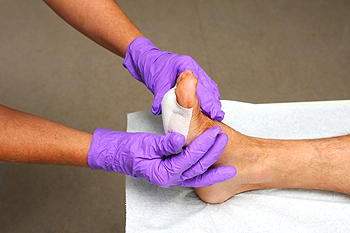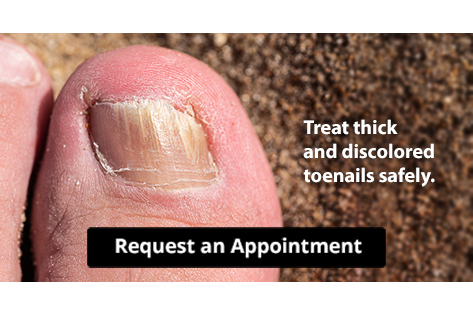Connect With Us
Blog
Items filtered by date: September 2025
Recognizing Symptoms of Fungal Toenails

Toenail fungus, also known as onychomycosis, is a common condition that affects the appearance and health of the toenails. It often begins as a white or yellow spot under the nail and can spread deeper, causing the nail to thicken and become discolored, brittle, or distorted in shape. In some cases, the nail may separate from the nail bed and emit an unpleasant odor. It may feel uncomfortable or painful, especially when wearing shoes. Causes include exposure to warm, moist environments, such as locker rooms or public showers, wearing sweaty shoes, nail injuries, or having a weakened immune system. A podiatrist can diagnose toenail fungus through a physical exam and lab testing. Treatment options include topical or oral antifungal medications or removing the affected nail. Early treatment improves results and helps prevent the infection from spreading. It is suggested that you make an appointment with a podiatrist at the first sign of toenail changes or discomfort.
For more information about treatment, contact Larry Slomowitz, DPM of California. Our doctor can provide the care you need to keep you pain-free and on your feet.
Toenail Fungus Treatment
Toenail fungus is a condition that affects many people and can be especially hard to get rid of. Fortunately, there are several methods to go about treating and avoiding it.
Antifungals & Deterrence
Oral antifungal medicine has been shown to be effective in many cases. It is important to consult with a podiatrist to determine the proper regiment for you, or potentially explore other options.
Applying foot powder on the feet and shoes helps keep the feet free of moisture and sweat.
Sandals or open toed shoes – Wearing these will allow air movement and help keep feet dry. They also expose your feet to light, which fungus cannot tolerate. Socks with moisture wicking material also help as well.
If you have any questions please contact our office located in Westlake Village, CA . We offer the newest diagnostic and treatment technologies for all your foot and ankle needs.
Climbing the Reconstructive Ladder for Foot Wounds

Foot wounds can be challenging, especially when they do not heal as expected. The reconstructive ladder is a step-by-step approach that podiatrists use to manage these wounds, starting with the simplest treatments and progressing to more advanced techniques if necessary. The goal is to restore both function and appearance of the foot. Initial treatments may include basic wound care, such as dressings and reducing pressure on the area. If healing slows or stops, options like skin grafts or flap surgery may be recommended. Each step on the ladder involves careful decisions to promote proper healing while maintaining mobility. Foot wounds caused by diabetes, injury, or other conditions require early and expert care. If you have a foot wound that is not improving, it is suggested that you make an appointment with a podiatrist to receive an accurate diagnosis and effective treatment.
Wound care is an important part in dealing with diabetes. If you have diabetes and a foot wound or would like more information about wound care for diabetics, consult with Larry Slomowitz, DPM from California. Our doctor will assess your condition and provide you with quality foot and ankle treatment.
What Is Wound Care?
Wound care is the practice of taking proper care of a wound. This can range from the smallest to the largest of wounds. While everyone can benefit from proper wound care, it is much more important for diabetics. Diabetics often suffer from poor blood circulation which causes wounds to heal much slower than they would in a non-diabetic.
What Is the Importance of Wound Care?
While it may not seem apparent with small ulcers on the foot, for diabetics, any size ulcer can become infected. Diabetics often also suffer from neuropathy, or nerve loss. This means they might not even feel when they have an ulcer on their foot. If the wound becomes severely infected, amputation may be necessary. Therefore, it is of the upmost importance to properly care for any and all foot wounds.
How to Care for Wounds
The best way to care for foot wounds is to prevent them. For diabetics, this means daily inspections of the feet for any signs of abnormalities or ulcers. It is also recommended to see a podiatrist several times a year for a foot inspection. If you do have an ulcer, run the wound under water to clear dirt from the wound; then apply antibiotic ointment to the wound and cover with a bandage. Bandages should be changed daily and keeping pressure off the wound is smart. It is advised to see a podiatrist, who can keep an eye on it.
If you have any questions please contact our office located in Westlake Village, CA . We offer the newest diagnostic and treatment technologies for all your foot and ankle needs.
Understanding Toe Pain From a Stubbed Toe

Toe pain is a common issue that can interfere with walking and daily activities. A stubbed toe occurs when the toe is forcefully hit against a hard surface, leading to bruising, swelling, or even fractures. The pain may be sharp at first and linger as the toe becomes inflamed. While most cases improve with rest, some injuries can be more severe and require medical attention. A podiatrist can determine if the toe is fractured, provide proper treatment, and help prevent long-term complications. If you have ongoing toe pain after stubbing your toe, it is suggested that you schedule an appointment with a podiatrist who can provide effective relief tips.
Toe pain can disrupt your daily activities. If you have any concerns, contact Larry Slomowitz, DPM of California. Our doctor can provide the care you need to keep you pain-free and on your feet.
What Causes Toe Pain?
Most severe toe pain is caused due to a sports injury, trauma from dropping something heavy on the toe, or bumping into something rigid. Other problems can develop over time for various reasons.
Toe pain can be caused by one or more ailments. The most common include:
- Trauma
- Sports injury
- Wearing shoes that are too tight
- Arthritis
- Gout
- Corns and calluses
- Hammertoe
- Bunions
- Blisters
- Ingrown toenails
- Sprains
- Fractures (broken bones)
- Dislocations
When to See a Podiatrist
- Severe pain
- Persistent pain that lasts more than a week
- Signs of infection
- Continued swelling
- Pain that prevents walking
Diagnosis
In many cases the cause of toe pain is obvious, but in others, a podiatrist may want to use more advanced methods to determine the problem. These can range from simple visual inspections and sensation tests to X-rays and MRI scans. Prior medical history, family medical history, and any recent physical traumatic events will all be taken into consideration for a proper diagnosis.
Treatment
Treatments for toe pain and injuries vary and may include shoe inserts, padding, taping, medicines, injections, and in some cases, surgery. If you believe that you have broken a toe, please see a podiatrist as soon as possible.
If you have any questions please contact our office located in Westlake Village, CA . We offer the newest diagnostic and treatment technologies for all your foot and ankle needs.
Reasons You Might Have Heel Pain

Heel pain can interfere with daily activity and mobility. In many cases, heel pain develops from overuse, repetitive stress, or wearing footwear that lacks adequate support. Running on hard surfaces, sudden increases in activity, or tightness in the calf muscles and Achilles tendon can also contribute to this type of pain. Injuries, such as a heel bone fracture from a fall or hard landing, may also be factors. Conditions including plantar fasciitis, bursitis, Achilles tendon inflammation, or the growth of bone spurs can further lead to tenderness, stiffness, and swelling at the heel. Pain may be felt under the heel, at the back of the heel, or along the Achilles tendon, depending on the underlying cause. A podiatrist can provide a full evaluation, offer proper treatment, and determine whether imaging or surgery may be needed. If you are experiencing heel pain, it is suggested that you schedule an appointment with a podiatrist for a diagnosis and appropriate treatment.
Many people suffer from bouts of heel pain. For more information, contact Larry Slomowitz, DPM of California. Our doctor can provide the care you need to keep you pain-free and on your feet.
Causes of Heel Pain
Heel pain is often associated with plantar fasciitis. The plantar fascia is a band of tissues that extends along the bottom of the foot. A rip or tear in this ligament can cause inflammation of the tissue.
Achilles tendonitis is another cause of heel pain. Inflammation of the Achilles tendon will cause pain from fractures and muscle tearing. Lack of flexibility is also another symptom.
Heel spurs are another cause of pain. When the tissues of the plantar fascia undergo a great deal of stress, it can lead to ligament separation from the heel bone, causing heel spurs.
Why Might Heel Pain Occur?
- Wearing ill-fitting shoes
- Wearing non-supportive shoes
- Weight change
- Excessive running
Treatments
Heel pain should be treated as soon as possible for immediate results. Keeping your feet in a stress-free environment will help. If you suffer from Achilles tendonitis or plantar fasciitis, applying ice will reduce the swelling. Stretching before an exercise like running will help the muscles. Using all these tips will help make heel pain a condition of the past.
If you have any questions, please feel free to contact our office located in Westlake Village, CA . We offer the newest diagnostic and treatment technologies for all your foot care needs.
Stop Your Toenail Fungus
Causes of In-Toeing in Your Child

In-toeing, sometimes called pigeon-toed walking, occurs when a child’s toes point inward while walking or running. It is commonly related to the rotation of the tibia in the lower leg or the femur in the upper leg. These changes in alignment usually occur during growth and often resolve on their own as a child develops. While in-toeing is typically painless, it may cause a child to trip more often or appear clumsy, which can be concerning for parents. Risk factors include family history, positioning in the womb, or sitting habits such as the “W” position. A podiatrist can evaluate your child’s feet, ankles, and legs to determine the cause of the in-toeing, observe gait patterns, and check for underlying bone abnormalities. In rare situations where bone deformities persist, surgery may be considered. If you have noticed unusual gait problems in your child, it is suggested that you make an appointment with a podiatrist for an evaluation and treatment.
The health of a child’s feet is vital to their overall well-being. If you have any questions regarding foot health, contact Larry Slomowitz, DPM of California. Our doctor can provide the care you need to keep you pain-free and on your feet.
Tips for Keeping Children's Feet Healthy
- Make sure their shoes fit properly
- Look for any signs of in-toeing or out-toeing
- Check to see if they have Clubfoot (condition that affects your child’s foot and ankle, twisting the heel and toes inward) which is one of the most common nonmajor birth defects.
- Lightly cover your baby’s feet (Tight covers may keep your baby from moving their feet freely, and could prevent normal development)
- Allow your toddler to go shoeless (Shoes can be restricting for a young child’s foot)
- Cut toenails straight across to avoid ingrown toenails
- Keep your child’s foot clean and dry
- Cover cuts and scrapes. Wash any scratches with soap and water and cover them with a bandage until they’ve healed.
If you have any questions, please feel free to contact our office located in Westlake Village, CA . We offer the newest diagnostic and treatment technologies for all your foot care needs.

